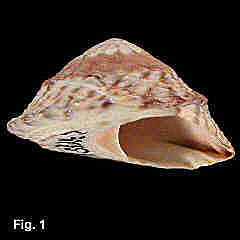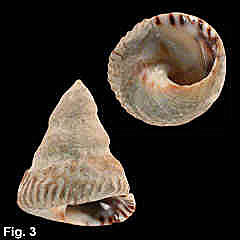|
|
|
|
|
Bembicium nanum (Lamarck, 1822) Description: Shell usually eroded; convex in outline, varying from squat (Fig. 1) to tall (Fig. 3) (ratio of height to width 0.49-1.47). Sculptured with axial folds, 15-20 on body whorl, varying from absent to strong but usually obsolete on body whorl. Axial folds crossed by 7-9 spiral grooves. Base with 4-7 spiral ribs. Columella smooth, outer lip thin, slightly thickened in adults. External coloration white, cream or pale yellow, usually obscured by erosion, with 18-38 oblique black stripes on the last whorl, usually relatively crisp but sometimes diffuse. Columella white or pale brown. Interior of outer lip cream or dark brown, edge of aperture white with 4-10 black or brown stripes. Size: Up to 22 mm in height, commonly about 15 mm. Distribution: Endemic to Australia; Yeppoon, Queensland, southwards to Port Lincoln, SA, including Tasmania. Habitat: On moderately exposed rocky shores, mid to high tide level. Abundant. Comparison: B. auratum has a coarsely nodulose periphery and more spiral grooves above the periphery of the last whorl than B. namum. B. auratum is usually not striped, or when it is striped, it has 11-17 diffuse stripes, while B. nanum usually has 18-38 distinct stripes. B. auratum has 7-11 ribs on the base, while B. nanum has 4-7. B. auratum is cream or dark brown on the inner edge of the outer lip, sometimes with 1-4 stripes, while B. nanum has a white edge to the lip crossed by 4-10 stripes. Synonymy: This species has frequently been misidentified as Bembicium melanostoma (Gmelin, 1791). A full synonymy is given by Reid (1988). Remarks: Both B. nanum and B. auratum are variable in shape and sculpture, and. juveniles are much flatter than adults. In B. nanum, juveniles of 6 mm basal diameter have a height about 50% of width, but adults of 18 mm basal diameter have height about the same as width. Very small juveniles of only a few millimeters diameter look quite different to adults. The variation within species and the similarity between species of Bembicium in Australia has led to many synonyms and much confusion for the names and the ranges of the species. The current understanding of the genus in Australia, as given by Reid (1988), is that it consists of five species; B. nanum and B. auratum as described here, plus the following three species;
In the family Littorinidae, sexes are separate and fertilization is internal. The male bears a penis to the right of the head, used to transfer sperm to the female. In this species gelatinous egg masses are deposited by the female in clusters attached to the rock surface in sheltered positions, in a fissure or under algae, in the habitat of the adults (Anderson, 1961). At Harbord, Anderson found that spawning occurred from the end of October to the end of April, but Underwood (1974) found spawning occurred from July to February at Cape Banks in Botany Bay.. The egg masses are small, ovoid-shaped transparent jelly masses, each containing 100-200 creamy white eggs. Veliger larvae hatch from the eggs after about 12 days, and enter the plankton as free-swimming individuals. The time spent in the plankton is unknown. Bembicium nanum lives on semi-exposed rocky shores in the upper intertidal zone, a habitat that it shares with the other common algal grazers Nerita atramentosa and Cellana tramoserica. It can be abundant, with densities of hundreds per square metre. The animals move around randomly to find a new food supply, moving 0.5-1 metre each day. Growth was studied by Underwood (1975) at Cape Banks in Botany Bay. He found that in 10 months from settlement animals grew to a shell diameter of 11 mm, at which size they were sexually mature. Growth then continued more slowly, with an estimated life span of 4-8 years. Only a small proportion of larvae that settle survive as adults, but then adult mortality is low, with most that reach adulthood dying of old age. Figs.1,2: Jervis Bay, NSW (C.319026) Fig. 3: Roseville, Middle Harbour, NSW (C.319047) |


